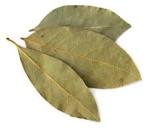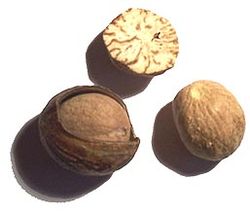Kala Namak / Black Salt
Whole Kala Namak salt crystals
Kala Namak or Himalayan Black Salt (Urdu کالا نمک; Bengali Biit lobon (বিট লবণ); Newari Be Chi; Nepali Birae Nun (बिरे नुन) ; Hindi काला नमक Marathi काळं मीठ ;kālā namak; Gujarati સંચળ Sanchal; Tamil இந்துப்பு; Malayalam ഇന്തുപ്പ്) also known as sulemani namak, black salt, or kala loon, is a type of rock salt, salty and pungent-smelling condiment used in South Asia. The condiment is composed largely of sodium chloride with several other components lending the salt its colour and smell. The smell is mainly due to its sulphur content. Due to the presence of Greigite (Fe3S4, Iron(II,III) sulfide) in the mineral, it forms brownish pink to dark violet translucent crystals when whole, and, when ground into a powder, it is light purple to pink in color.
Production
The raw material for producing kala namak was originally obtained from natural halite from mines in Bangladesh, India, Nepal and Pakistan in certain locations of the Himalayas salt ranges, or from salt harvested from the North Indian salt lakes of Sambhar or Didwana and Mustang of Nepal
Traditionally, the salt was transformed from its raw natural forms into commercially sold kala namak through a reductive chemical process that transforms some of the naturally occurring sodium sulphate of the raw salt into pungent hydrogen sulfide and sodium sulfide. This involves firing the raw salts in a furnace for 24 hours while sealed in a ceramic jar with charcoal along with small quantities of harad seeds, aamla, bahera, babul bark, or Sajji. The fired salt is then cooled, stored, and aged prior to sale. Kala namak is prepared in this manner in Northern India with production concentrated in the Hisar district, Haryana. The salt crystals appear black in colour, and are usually ground to a fine powder which is pink in colour.
Although the kala namak can be produced from natural salts with the required compounds, it is common to now manufacture it synthetically. This is done through combining ordinary sodium chloride admixed with smaller quantities of sodium sulphate, sodium bisulphate and ferric sulphate, which is then chemically reduced with charcoal in a furnace. Reportedly, it is also possible to create similar products through reductive heat treatment of sodium chloride, 5-10 percent of sodium carbonate, sodium sulphate, and some sugar.
Composition
Kala namak consists primarily of sodium chloride and trace impurities of sodium sulphate, sodium bisulfate, sodium bisulfite, sodium sulphide, iron sulfide and hydrogen sulfide.
Sodium chloride provides kala namak with its salty taste, iron sulphide provides its dark violet hue, and all the sulphur compounds give kala namak its slight savory taste as well as a highly distinctive smell, with hydrogen sulphide being the most prominent contributor to the smell. The acidic bisulfates/bisulfites contribute a mildly sour taste. Although hydrogen sulphide is toxic in high concentrations, the amount present in kala namak used in food is small and thus its effects on health are negligible: Hydrogen sulphide is also one of the components of the odor of rotten eggs and boiled milk.
Indian Black Salt
Indian black salt has been used as a condiment for many hundreds of years in Asian countries surrounding the Himalayan mountains. It was originally obtained from either natural volcanic mines in Northern India and Pakistan or the surrounding salt lakes of Sambhar or Didwana.
Potential Health Benefits
Indian black salt is considered a cooling spice in ayurvedic medicine and is recommended for many health issues such as constipation, indigestion, heartburn, bloating, flatulence, goiter, poor eyesight and hysteria, according to the book “Herbs that Heal.” In India, black salt is sometimes recommended to people on low-salt diets due to hypertension because it’s believed to be lower in sodium content compared to regular table salt. Of course, the composition of Indian black salt varies quite a bit and depends mainly on whether it’s manufactured using traditional or modern techniques. Synthetically made black salt has a sodium content very near to regular table salt. Discuss your salt options with your doctor if you have high blood pressure.
Uses
Kala Namak is used extensively in South Asian cuisines of Bangladesh, India and Pakistan as a condiment or added to chaats, chutneys, salads, all kinds of fruits, raitas and many other savory Indian snacks. Chaat masala, an Indian spice blend, is dependent upon black salt for its characteristic sulfurous hard-boiled egg aroma. Those who are not accustomed to black salt often describe the smell as similar to rotten eggs. Kala Namak is appreciated by some vegans in dishes that mimic the taste of eggs. It is used, for example, to season tofu to mimic an egg salad.
Kala Namak is considered a cooling spice in ayurvedic medicine and is used as a laxative and digestive aid. It is also believed to relieve intestinal gas and heartburn. It is used in Jammu to cure goiters. This salt is also used to treat hysteria, and for making toothpastes by combining it with other mineral and plant ingredients.
Cooking Benefits
Indian black salt is used extensively on Indian food, including chutneys, yogurts, pickles, salads and all kinds of fruits. It’s often appreciated by strict vegans because it mimics the taste of eggs in tofu and other vegetarian dishes. During the hot Indian summer months, it’s also sometimes used to flavor cool drinks, which is a practical way to replace sodium lost through excessive perspiration.
Ref. http://www.livestrong.com/article/557587-what-are-the-health-benefits-of-indian-black-salt/
Ref. http://en.wikipedia.org/wiki/Kala_Namak
Nick’s kitchen medical Disclaimer:
- Nick’s kitchen is for Vegetarians. It sometimes provides education and support to individuals who want to become vegetarian, or move toward a more vegetarian diet.
- Nick’s kitchen provides some information on vegetarian and vegan diets to the best of their knowledge and abilities.
- Nick’s kitchen does not claim to be health care professional, nutritionist, nor does it claims to treat any illness through vegan or vegetarian diet.
- If you have a medical condition,Nick’s kitchen recommend that you consult your health care professionals before changing your diet.
- Any changes that you make to your diet, and the results of those changes, are your decision and your responsibility.




















